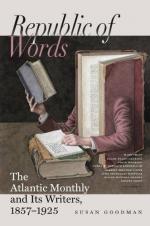are to be had at the furriers’ shops in Quebec,
where there is a considerable demand for them by members
of snow-shoe clubs, and others whose occupations or
amusements render that style of costume appropriate
for their wear. The older women dress in the
ordinary squaw costume, with short, narrow petticoats,
and embroidered
metasses, or leggings.
When going out, they fold a blue blanket over all,
and put on a regular, unpicturesque, stove-pipe hat,
with a band of tin-foil around it,—which
makes them look like one of those mulatto coachmen
one sees now and then on the box of a
bonton
barouche, with his silver-mounted hat and double-caped
blue box-coat. The young girls are disposed to
innovations upon the petticoats, and modifications
of the
metasses. Once I saw one standing
on a great gray crag at the foot of the fall.
She looked extremely picturesque at a little distance,
giving a nice bit of local color to the scene with
her scarlet legs; but on a nearer approach, much of
the value of the color disappeared before the unromantic
facts of a pale-face petticoat and patent-leather
gaiter-boots. I have noticed several of the younger
people here with brown hair and blue or gray eyes,
significant that the aboriginal blood is being gradually
diluted. In another generation or two, there
will be little of it left among them. But the
correspondents of the press, who described some of
these Indians seen by them at Quebec, are mistaken
in attributing to them an admixture of Irish blood.
Until within eight years past, there were few, if any,
Irish to be found in the neighborhood of Lorette.
Since that time, the construction of the Quebec water-works,
which are supplied from Lake St. Charles, has given
employment to hundreds of the Hibernian stock in that
neighborhood; and I know not whether their influence
as regards race may not be now discernible in the
features of many pugnacious Huronites of tender years:
but the white element traceable in the lineaments of
the present and passing generations of the settlement
is distinctly attributable to the proximity of the
French-Canadian, whose language has been transfused
into them with the blood.
Few, if any, of the older people of Lorette speak
English,—Huron and French being the only
languages at their command. Since the building
of the great reservoir, however, many of the rising
generation are picking up the English tongue in its
roundest Irish form. Previously, matters were
the reverse. I once noticed a handsome, brown-faced
boy there, who used to come about with a bow and arrows,
soliciting coppers, which were placed one by one in
a split stick, shot at, and pocketed by the archer,
if hit,—as they almost always were.
He spoke Indian and French, and I took him for an
olive-branch of the tribe; but, on questioning him,
he told me that his name was Bill Coogan, and that
he first saw the light, I think, in Cork, Ireland.




